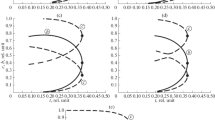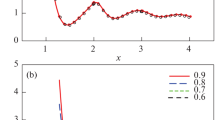Abstract
The influence of hydrogen bonds on the physical and chemical properties of hydrogen bonding fluid system of A a D d type is investigated from two viewpoints by the principle of statistical mechanics. In detail, we proposed two new ways that can be used to obtain the equilibrium size distribution of the hydrogen bonding clusters, and derived the analytical expression of a relationship between the hydrogen bonding free energy and hydrogen bonding degree. For the nonlinear hydrogen bonding systems, it is shown that the sol-gel phase transition can take place under proper conditions, which is further proven to be a kind of geometrical phase transition rather than a thermodynamic one. Moreover, several problems associated with the geometrical phase transition and liquid-solid phase transition in nonlinear hydrogen bonding systems are discussed.
Similar content being viewed by others
References
Jeffrey G A. An Introduction to Hydrogen Bonding. Oxford: Oxford University Press, 1997. 11–202
Dore J C, Teixeira J. Hydrogen-Bonded Liquids. Dordrecht: Kulumer Academic Publishers, 1991. 89–405
Scheiner S. Hydrogen Bonding: A Theoretical Perspective. New York: Oxford University Press, 1997. 3–345
Geiger A, Stanley H E. Low-density “patches” in the hydrogen-bond network in liquid water. Phys Rev Lett, 1982, 49: 1749–1752
Kalinichev A G, Bass J D. Hydrogen bonding in supercritical water. J Phys Chem A, 1997, 101: 9720–9727
Stanley H E, Blumberg R L, Geiger A. Gelation models of hydrogen bond networks in liquid water. Phys Rev B, 1983, 26: 1626–1629
Blumberg R L, Stanley H E, Geiger A, et al. Connectivity of hydrogen bonds in liquid water. J Chem Phys, 1984, 80: 5230–5241
Tanaka F. Theory of thermoreversible gelation. Macromolecules, 1989, 22: 1988–1994
Tanaka F, Stockmayer W H. Thermoreversible gelation with junctions of variable multiplicity thermoreversible gelation. Macromolecules, 1996, 27: 3943–3954
Shoji M, Tanaka F. Theoretical study of hydrogen bonded supramolecular liquid crystals. Macromolecules, 2002, 35: 7460–7472
Semenov A N, Rubinstein M. Thermoreversible gelation in solutions of associative polymers. 1. Statics. Macromolecules, 1998, 31, 1373–1385
Veytsman B A. Are lattice models valid for fluids with hydrogen bonds? J Phys Chem, 1990, 94: 8499–8500
Panayiotou C, Sanchez I C. Hydrogen bonding in fluids. J Phys Chem, 1991, 95: 10090–10097
Veytsman B A. Equation of state for hydrogen-bonded systems. J Phys Chem B, 1998, 102: 7515–7517
Aghamiri S F, Modarres H, Mansoori G A. A new approach to the hydrogen bonded fluids based on the conformal solution concept. J Phys Chem B, 2001, 105: 2820–2825
Erukhimovich I Y. Statistical theory of sol-gel transition in weak gels. JETP, 1998, 31: 1373–1385
Fecko C J, Eaves J D, Loparo J J, et al. Ultrafast hydrogen-bond dynamics in the infrared spectroscopy of water. Science, 2003, 301: 1698–1702
Flory P J. Principles of Polymer Chemistry. New York: Cornell University Press, 1953. 347–398
Stockmayer W H. Theory of molecular size distribution and gel fraction in branched-chain polymers. J Chem Phys, 1943, 11: 45–55
Tang A C. Statistical Theory of Polymeric Reactions. Beijing: Science Press, 1981. 1–66
Tang, A C, Jiang Y S. The problems of gelations of three dimensional polycondensation reactions. Science Record, 1958, II(3): 110–115
Xiao X C, Li Z S, Sun C C, et al. Intrinsic symmetry of the A a B b type distribution. Macrolmol Theo Simul, 1994, 3: 601–606
Wang H J, Ba X W, Zhao M. Reaction dynamics and statistical theory for the growth of hydrogen bonding clusters. Sci China Ser B-Chem, 2002, 45(2): 113–121
Sawada H. Thermodynamics of Polymerization. Translated in Chinese by Yan H K, Jin S J. Beijing: Science Press, 1985. 153–197
Wang H J, Ba X W, Zhao M, et al. The scaling study for the hydrogen bonding networks. Chem Phys Lett, 2001, 342: 347–352
Li Z S, Xiao X C, Sun J Z, et al. The intrinsic invariant property of the number faction distribution of polymers. Sci China Ser B-Chem (in Chinese), 1993, 23(9): 897–904
Coniglio A, Stanley H E, Klein W. Solvent effects on polymer gels. Phys Rev, 1982, B25: 6805–6821
Stanley H E. Introduction to Phase Transitions and Critical Phenomena. Oxford: Oxford University Press, 1971. 1–18
Eyring H, Henderson D, Stover B J, et al. Statistical Mechanics and Dynamics. New York: John Wiley & Sons Inc, 1964. 354–382
Author information
Authors and Affiliations
Corresponding author
Rights and permissions
About this article
Cite this article
Wang, H., Hong, X., Gu, F. et al. Statistical theory for hydrogen bonding fluid system of A a D d type (I): The geometrical phase transition. SCI CHINA SER B 49, 499–506 (2006). https://doi.org/10.1007/s11426-006-2034-5
Received:
Accepted:
Issue Date:
DOI: https://doi.org/10.1007/s11426-006-2034-5




